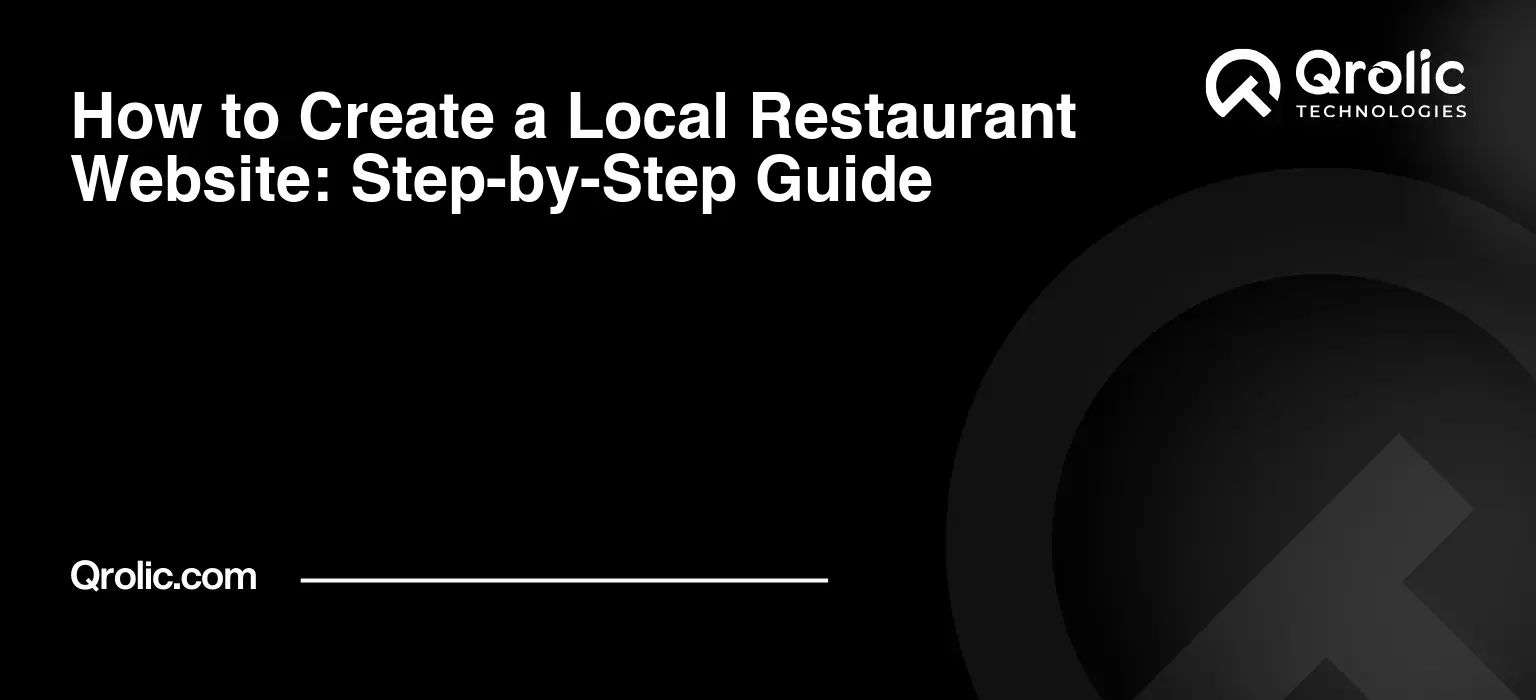Quick Summary:
- A website is essential for restaurant visibility and sales.
- Plan carefully, design well, and use great photos.
- Optimize your content and SEO for online search.
- Keep your website updated, secure, and fresh.
Table of Contents
- Why Your Restaurant Needs a Website (Now More Than Ever)
- Lost Without a Website? You’re Losing Customers
- Controlling Your Narrative: It’s Your Story, Tell It!
- Beyond a Menu: Offering Convenience and Building Relationships
- The Competitive Edge: Standing Out From the Crowd
- Step 1: Planning Your Local Restaurant Website – Setting the Table for Success
- Defining Your Target Audience: Who Are You Trying to Reach?
- Identifying Key Website Pages: The Core Menu of Content
- Keyword Research: Making Sure People Can Find You
- Competitor Analysis: Learning From the Best (and Worst)
- Setting a Budget: Knowing What You Can Spend
- Step 2: Choosing Your Domain Name and Web Hosting – Establishing Your Online Address
- Selecting the Perfect Domain Name: Memorable, Brandable, and Relevant
- Choosing a Reliable Web Hosting Provider: Speed, Security, and Support
- Connecting Your Domain Name to Your Web Hosting: Linking Your Address to Your Home
- Step 3: Selecting a Website Builder or CMS – Choosing Your Construction Tool
- Website Builders vs. CMS: Understanding the Difference
- WordPress: The King of Content Management
- Wix and Squarespace: User-Friendly Alternatives
- Choosing the Right Platform for Your Restaurant
- Step 4: Designing Your Restaurant Website – Creating an Appetizing Visual Experience
- Choosing a Theme or Template: The Foundation of Your Design
- Creating a Consistent Brand Identity: Visual Harmony
- High-Quality Photography: Making Mouths Water
- Optimizing for Mobile Devices: Reaching Customers On-the-Go
- User-Friendly Navigation: Guiding Visitors Seamlessly
- Call to Actions: Encouraging Engagement
- Step 5: Creating Compelling Content – Serving Up Information That Sells
- Homepage: Making a Great First Impression
- Menu: Tempting Taste Buds Online
- About Us: Telling Your Story
- Location & Contact: Making It Easy to Find You
- Blog (Optional): Engaging and Informing Your Audience
- Step 6: Optimizing for Search Engines (SEO) – Making Sure You Get Found
- Keyword Research: The Foundation of SEO
- On-Page Optimization: Tuning Your Website for Search Engines
- Off-Page Optimization: Building Authority and Trust
- Local SEO: Targeting Local Customers
- Using SEO Tools: Tracking Your Progress
- Step 7: Testing and Launching Your Website – Opening Your Doors to the Digital World
- Testing Your Website: Ensuring a Smooth Experience
- Launching Your Website: Making It Live
- Monitoring Your Website: Keeping Things Fresh
- Step 8: Maintaining and Updating Your Website – Keeping Your Restaurant Website Fresh
- Regular Security Updates: Protecting Your Online Presence
- Backups: Preparing for the Unexpected
- Content Updates: Keeping Things Fresh and Engaging
- Monitoring Website Performance: Identifying Areas for Improvement
- Gathering Customer Feedback: Improving the User Experience
- Staying Up-to-Date with SEO Best Practices: Maintaining Your Search Engine Ranking
- Qrolic Technologies: Your Partner in Food Service Design and Digital Success
- Conclusion: Your Recipe for Online Restaurant Success
Why Your Restaurant Needs a Website (Now More Than Ever)

In today’s digital world, a website isn’t just a nice-to-have; it’s the cornerstone of your restaurant’s online presence and a crucial ingredient for long-term success. Think of it as your 24/7 digital greeter, showcasing your menu, ambiance, and personality to potential customers. Forget hoping people stumble upon your restaurant; a website allows you to invite them in!
Lost Without a Website? You’re Losing Customers
Here’s the harsh reality: if you don’t have a website, people looking for a place to eat nearby might never find you. They’re searching for “restaurants near me,” “best pizza in [city],” or “vegetarian options [neighborhood],” and if you’re not there, your competitors are. A website ensures you’re visible when customers are actively looking for exactly what you offer.
Controlling Your Narrative: It’s Your Story, Tell It!
Social media is great, but you don’t control the narrative. A website provides a dedicated space to tell your restaurant’s story, highlighting your unique history, chef’s philosophy, and commitment to quality ingredients. Showcase your delicious food with high-quality photos and videos that make mouths water.
Beyond a Menu: Offering Convenience and Building Relationships
A website does more than just display your menu. It allows you to:
- Offer Online Ordering & Takeout: Seamlessly integrate online ordering for takeout and delivery, capturing customers who prefer to dine at home. This boosts revenue and expands your reach.
- Manage Reservations: Implement an online reservation system to streamline bookings, reducing phone calls and maximizing table turnover.
- Promote Specials & Events: Easily update your website with daily specials, upcoming events, and promotions, attracting new and repeat customers.
- Collect Customer Feedback: Integrate a contact form and customer review section to gather valuable feedback and improve your services.
- Build an Email List: Offer incentives (like a discount on their first order) to encourage visitors to subscribe to your email list, allowing you to nurture relationships and announce exclusive offers.
The Competitive Edge: Standing Out From the Crowd
In a crowded marketplace, a professional website sets you apart from the competition. It conveys professionalism, trustworthiness, and a commitment to providing a superior dining experience. It’s the difference between looking like a hobbyist and looking like a serious player.
Step 1: Planning Your Local Restaurant Website – Setting the Table for Success
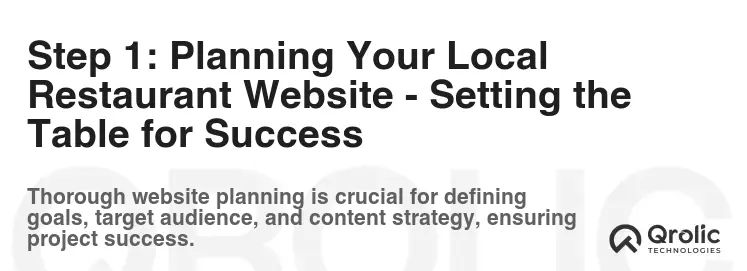
Before diving into design and development, it’s crucial to lay a solid foundation by planning your website’s structure, content, and target audience. This step prevents wasted time and ensures your website effectively achieves its goals. Think of it as meticulously prepping your ingredients before you start cooking.
Defining Your Target Audience: Who Are You Trying to Reach?
Understanding your target audience is paramount. Are you catering to families, young professionals, tourists, or a specific niche (e.g., vegan diners)? Your website’s design, language, and imagery should resonate with your ideal customer. Consider these factors:
- Demographics: Age, income, location, education level.
- Interests: What kind of food do they like? What are their dining habits? Are they interested in sustainability, local sourcing, or specific dietary options?
- Pain Points: What are their frustrations when choosing a restaurant? (e.g., difficulty finding parking, long wait times, limited menu options).
- Search Intent: What keywords are they likely using to find restaurants like yours?
Identifying Key Website Pages: The Core Menu of Content
Every restaurant website needs a set of essential pages to provide visitors with the information they need. Here’s a basic list, which you can customize based on your specific needs:
- Homepage: The first impression. Showcase your best food, ambiance, and unique selling points.
- Menu: Detailed descriptions of your dishes, including prices, ingredients, and dietary information. Use high-quality photos.
- About Us: Tell your restaurant’s story, highlighting your history, mission, and team. Humanize your brand.
- Location & Contact: Address, phone number, email address, and operating hours. Embed a Google Map for easy directions.
- Reservations: A dedicated page for online reservations (if applicable).
- Order Online: Seamless integration with your online ordering system.
- Gallery: Showcase your restaurant’s ambiance, food, and events through high-quality photos and videos.
- Specials & Events: Promote daily specials, upcoming events, and holiday menus.
- Blog (Optional): Share recipes, behind-the-scenes stories, and industry news. Great for SEO.
- Careers (Optional): Post job openings and attract talented staff.
- Privacy Policy & Terms of Service: Legal compliance and transparency.
Keyword Research: Making Sure People Can Find You
Keyword research is the process of identifying the terms people use to search for restaurants like yours online. This information helps you optimize your website content to improve your search engine ranking. Use tools like Google Keyword Planner, SEMrush, or Ahrefs to identify relevant keywords. Focus on:
- Location-Based Keywords: “restaurants near me,” “pizza [city],” “Italian food [neighborhood].”
- Cuisine-Specific Keywords: “best sushi,” “vegan restaurant,” “Mexican food.”
- Menu Item Keywords: “burgers,” “pasta,” “salads.”
- Descriptive Keywords: “family-friendly restaurant,” “romantic dinner,” “outdoor seating.”
Competitor Analysis: Learning From the Best (and Worst)
Analyze the websites of your competitors. What are they doing well? What could they improve? Identify their strengths and weaknesses and use this information to differentiate your own website. Look at their:
- Design and User Experience: Is their website easy to navigate? Is it visually appealing?
- Content: What kind of information do they provide? Is it engaging and informative?
- SEO: What keywords are they targeting? How are they ranking in search results?
- Online Ordering and Reservations: How seamless is the process?
Setting a Budget: Knowing What You Can Spend
Website creation can range from free (using basic website builders) to thousands of dollars (for custom design and development). Establish a realistic budget based on your needs and resources. Consider the costs associated with:
- Domain Name: Typically $10-$20 per year.
- Web Hosting: Starts at a few dollars per month and can increase based on storage and bandwidth needs.
- Website Builder or CMS: Some are free, while others require a monthly or annual subscription.
- Design and Development: Can range from a few hundred dollars to several thousand.
- Plugins and Extensions: Some are free, while others require a one-time or recurring fee.
- Professional Photography: Highly recommended for showcasing your food and ambiance.
- SEO Services: If you need help optimizing your website for search engines.
Step 2: Choosing Your Domain Name and Web Hosting – Establishing Your Online Address
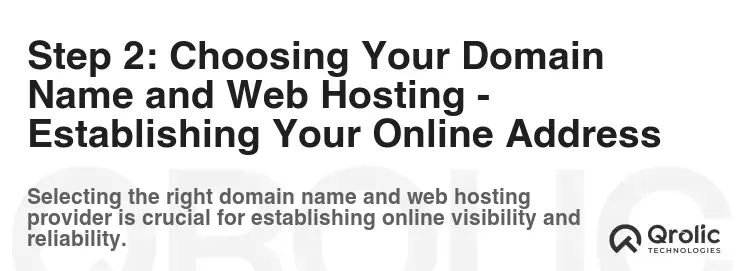
Your domain name is your restaurant’s online address, and your web hosting is where your website files are stored. Choosing the right domain name and web hosting provider is crucial for establishing a professional and reliable online presence. It’s like picking the perfect location and building a strong foundation for your restaurant.
Selecting the Perfect Domain Name: Memorable, Brandable, and Relevant
Your domain name should be easy to remember, brandable, and relevant to your restaurant. Here are some tips:
- Keep it Short and Simple: Avoid long, complicated names that are difficult to spell and remember.
- Use Relevant Keywords: Include keywords that describe your restaurant or cuisine (e.g., “PizzariaRoma,” “TacosElRey”).
- Consider Your Location: Include your city or neighborhood in your domain name (e.g., “BostonBurgerCo,” “BrooklynBagels”).
- Choose the Right Extension: “.com” is the most common and recognizable extension, but consider “.restaurant” or “.cafe” if they are available.
- Check for Availability: Use a domain name registrar like GoDaddy, Namecheap, or Google Domains to check if your desired domain name is available.
- Protect Your Brand: Register variations of your domain name (e.g., with different extensions or misspellings) to prevent competitors from using similar names.
Choosing a Reliable Web Hosting Provider: Speed, Security, and Support
Your web hosting provider stores your website files and makes them accessible to visitors. Choose a reliable provider that offers:
- Uptime Guarantee: Ensures your website is available to visitors most of the time. Look for at least 99.9% uptime.
- Fast Loading Speeds: Website Speed is crucial for user experience and SEO. Choose a provider with fast servers and optimized infrastructure.
- Security Features: Protects your website from hackers and malware. Look for features like SSL certificates, firewalls, and regular backups.
- Scalability: Allows you to easily upgrade your hosting plan as your website grows.
- Customer Support: Provides timely and helpful assistance when you need it. Look for 24/7 support via phone, email, or chat.
- WordPress Compatibility: If you plan to use WordPress (highly recommended), choose a hosting provider that offers optimized WordPress hosting.
Some popular web hosting providers include:
- Bluehost: Affordable and user-friendly, especially for beginners.
- SiteGround: Known for its fast loading speeds and excellent customer support.
- HostGator: Offers a variety of hosting plans and features.
- WP Engine: Specialized WordPress hosting with advanced features.
- Kinsta: Premium WordPress hosting with a focus on performance and security.
Connecting Your Domain Name to Your Web Hosting: Linking Your Address to Your Home
Once you’ve purchased your domain name and web hosting, you need to connect them. This typically involves updating your domain name’s DNS settings to point to your web hosting server. Your web hosting provider will provide you with the necessary DNS information and instructions.
Step 3: Selecting a Website Builder or CMS – Choosing Your Construction Tool

A website builder or Content Management System (CMS) provides the tools you need to create and manage your website’s content. There are many options available, each with its own strengths and weaknesses. It’s like choosing the right set of knives in the kitchen.
Website Builders vs. CMS: Understanding the Difference
- Website Builders: User-friendly platforms with drag-and-drop interfaces, making them ideal for beginners. Examples include Wix, Squarespace, and Weebly. They offer a more streamlined and simplified approach, often at the expense of flexibility and customization.
- CMS: More powerful and flexible platforms that require some technical knowledge. WordPress is the most popular CMS, but others include Joomla and Drupal. They provide greater control over your website’s design and functionality.
WordPress: The King of Content Management
WordPress is the most popular CMS in the world, powering over 40% of all websites. It’s a versatile platform that can be used to create any type of website, from simple blogs to complex e-commerce stores. WordPress offers:
- Flexibility and Customization: Thousands of themes and plugins available to customize your website’s design and functionality.
- SEO-Friendliness: WordPress is designed to be search engine friendly, making it easier to rank your website in search results.
- Large Community and Support: A vast community of developers and users provides support and resources.
- Scalability: WordPress can handle a large amount of traffic and content.
- Open Source: Free to use and modify.
Wix and Squarespace: User-Friendly Alternatives
Wix and Squarespace are popular website builders that offer a more streamlined and user-friendly experience than WordPress. They are ideal for beginners who want to create a simple website without coding. However, they offer less flexibility and customization than WordPress.
- Wix: Offers a drag-and-drop interface and a wide range of templates.
- Squarespace: Known for its beautiful designs and user-friendly interface.
Choosing the Right Platform for Your Restaurant
The best platform for your restaurant depends on your technical skills, budget, and needs.
- WordPress: Ideal if you want maximum flexibility, customization, and SEO power. Requires some technical knowledge, but there are plenty of resources available to help you learn.
- Wix or Squarespace: Ideal if you want a simple, user-friendly platform and don’t need a lot of customization.
Step 4: Designing Your Restaurant Website – Creating an Appetizing Visual Experience
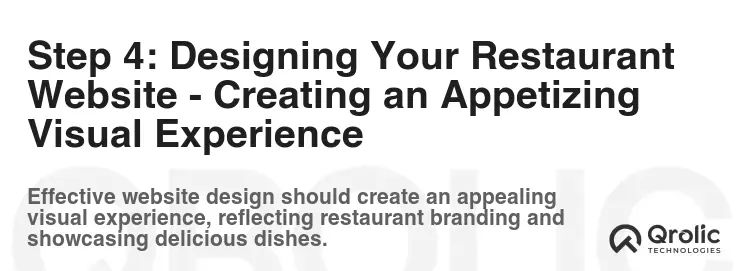
Your website’s design is crucial for attracting and engaging visitors. It should be visually appealing, easy to navigate, and reflect your restaurant’s brand. Think of it as creating the perfect ambiance for your dining room.
Choosing a Theme or Template: The Foundation of Your Design
Themes and templates provide a pre-designed layout and style for your website. Choose a theme or template that is:
- Responsive: Looks great on all devices (desktops, tablets, and smartphones).
- Mobile-Friendly: Optimized for mobile users. Most people will access your website on their phones.
- Visually Appealing: Reflects your restaurant’s brand and ambiance.
- Easy to Customize: Allows you to easily change colors, fonts, and images.
- SEO-Optimized: Designed to be search engine friendly.
Many free and premium themes and templates are available for WordPress, Wix, and Squarespace. Look for themes specifically designed for restaurants.
Creating a Consistent Brand Identity: Visual Harmony
Maintain a consistent brand identity throughout your website. Use the same colors, fonts, and logo that you use in your other marketing materials. This helps to create a cohesive brand image and build recognition.
High-Quality Photography: Making Mouths Water
Use high-quality photos of your food, restaurant ambiance, and team. Professional photography is highly recommended. Invest in a professional photographer or learn how to take great photos yourself. Avoid using stock photos whenever possible.
Optimizing for Mobile Devices: Reaching Customers On-the-Go
Ensure your website is optimized for mobile devices. Most people will access your website on their smartphones. A mobile-friendly website is easy to navigate on small screens and loads quickly.
User-Friendly Navigation: Guiding Visitors Seamlessly
Make it easy for visitors to find the information they need. Use clear and concise navigation menus. Organize your content logically. Include a search bar to allow visitors to quickly find specific information.
Call to Actions: Encouraging Engagement
Use clear and compelling call to actions to encourage visitors to take the next step. Examples include:
- “Order Online”
- “Make a Reservation”
- “View Menu”
- “Contact Us”
- “Join Our Email List”
Place call to actions prominently on your website.
Step 5: Creating Compelling Content – Serving Up Information That Sells

Your website’s content is what will attract and engage visitors. It should be informative, engaging, and optimized for search engines. Think of it as crafting the perfect menu description.
Homepage: Making a Great First Impression
Your homepage is the first impression visitors will have of your restaurant. It should:
- Clearly communicate your restaurant’s unique selling points.
- Showcase your best food and ambiance.
- Include a clear call to action.
- Be visually appealing and easy to navigate.
Use high-quality images and videos to capture visitors’ attention.
Menu: Tempting Taste Buds Online
Your menu is one of the most important pages on your website. It should:
- Be easy to read and navigate.
- Include detailed descriptions of your dishes, including ingredients and prices.
- Use high-quality photos of your food.
- Indicate dietary options (e.g., vegetarian, vegan, gluten-free).
- Be available in a downloadable PDF format.
About Us: Telling Your Story
Your “About Us” page is an opportunity to tell your restaurant’s story and connect with visitors on a personal level. It should:
- Highlight your restaurant’s history, mission, and values.
- Introduce your team.
- Share your passion for food and hospitality.
- Include photos of your team and restaurant.
Location & Contact: Making It Easy to Find You
Your “Location & Contact” page should provide all the information visitors need to find and contact your restaurant. It should include:
- Your restaurant’s address, phone number, and email address.
- Your operating hours.
- A Google Map embedded on the page.
- A contact form.
Blog (Optional): Engaging and Informing Your Audience
A blog can be a great way to engage with your audience and improve your website’s SEO. Share:
- Recipes
- Behind-the-scenes stories
- Industry news
- Tips for cooking and dining
Step 6: Optimizing for Search Engines (SEO) – Making Sure You Get Found

SEO is the process of optimizing your website to rank higher in search engine results. This is crucial for attracting organic traffic to your website. Think of it as making sure your restaurant is listed in all the local directories.
Keyword Research: The Foundation of SEO
As mentioned earlier, keyword research is the process of identifying the terms people use to search for restaurants like yours online. Use these keywords throughout your website’s content, including:
- Page Titles
- Meta Descriptions
- Headings
- Body Text
- Image Alt Text
On-Page Optimization: Tuning Your Website for Search Engines
On-page optimization involves optimizing the content and structure of your website to improve its search engine ranking. This includes:
- Using relevant keywords in your page titles and meta descriptions.
- Creating high-quality, informative content.
- Using headings and subheadings to structure your content.
- Optimizing your images for the web.
- Ensuring your website is mobile-friendly.
- Improving your website’s loading speed.
Off-Page Optimization: Building Authority and Trust
Off-page optimization involves building links to your website from other websites. This helps to improve your website’s authority and trust in the eyes of search engines. This includes:
- Submitting your website to online directories.
- Getting listed in local business directories.
- Building relationships with other businesses and bloggers.
- Creating high-quality content that people will want to link to.
- Actively engaging on social media.
Local SEO: Targeting Local Customers
Local SEO is the process of optimizing your website and online presence to rank higher in local search results. This is crucial for attracting customers in your local area. This includes:
- Claiming your Google My Business listing.
- Optimizing your Google My Business listing with relevant information and photos.
- Getting reviews from customers on Google, Yelp, and other review sites.
- Using local keywords throughout your website’s content.
- Building local citations (mentions of your business name, address, and phone number on other websites).
Using SEO Tools: Tracking Your Progress
Use SEO tools like Google Search Console, Google Analytics, SEMrush, and Ahrefs to track your website’s performance and identify areas for improvement.
Step 7: Testing and Launching Your Website – Opening Your Doors to the Digital World

Before launching your website, it’s crucial to thoroughly test it to ensure everything is working properly. Think of it as a soft opening for your restaurant.
Testing Your Website: Ensuring a Smooth Experience
Test your website on different devices and browsers to ensure it looks and functions correctly. Check:
- Responsiveness: Does your website look good on all devices?
- Functionality: Are all links working? Is the contact form working? Is the online ordering system working?
- Spelling and Grammar: Proofread your content carefully.
- Loading Speed: Is your website loading quickly?
- Security: Is your website secure?
Launching Your Website: Making It Live
Once you’ve tested your website and are confident that it’s working properly, you can launch it. This involves:
- Making your website live on your domain name.
- Submitting your website to search engines.
- Promoting your website on social media and other channels.
Monitoring Your Website: Keeping Things Fresh
After launching your website, it’s important to monitor its performance and make updates as needed. Track:
- Website Traffic
- Search Engine Rankings
- Customer Feedback
Keep your website content fresh and up-to-date. Add new content regularly to keep visitors engaged and improve your search engine ranking.
Step 8: Maintaining and Updating Your Website – Keeping Your Restaurant Website Fresh

Your website isn’t a “set it and forget it” project. Regular maintenance and updates are crucial to keep it secure, functional, and relevant. Think of it as regularly cleaning and maintaining your restaurant.
Regular Security Updates: Protecting Your Online Presence
Keep your website’s software (WordPress, plugins, themes) up-to-date to protect it from security vulnerabilities. Hackers often target outdated software. Enable automatic updates where possible.
Backups: Preparing for the Unexpected
Regularly back up your website’s files and database. This will allow you to quickly restore your website if something goes wrong (e.g., hacking, server crash, accidental deletion). Many web hosting providers offer automatic backup solutions.
Content Updates: Keeping Things Fresh and Engaging
Keep your website content fresh and up-to-date. Add new blog posts, update your menu, and promote special events. This will keep visitors engaged and improve your search engine ranking.
Monitoring Website Performance: Identifying Areas for Improvement
Use Google Analytics and other tools to monitor your website’s performance. Track:
- Website Traffic
- Bounce Rate
- Conversion Rate
- Search Engine Rankings
Identify areas for improvement and make changes accordingly.
Gathering Customer Feedback: Improving the User Experience
Solicit feedback from your customers about their experience on your website. Use online surveys, feedback forms, and social media to gather feedback. Use this feedback to improve your website’s design, content, and functionality.
Staying Up-to-Date with SEO Best Practices: Maintaining Your Search Engine Ranking
SEO is constantly evolving. Stay up-to-date with the latest SEO best practices and make changes to your website accordingly.
Qrolic Technologies: Your Partner in Food Service Design and Digital Success

Qrolic Technologies (https://qrolic.com/) understands the unique challenges and opportunities facing local restaurants. We offer a range of services to help you create a stunning and effective website that drives business.
Our Expertise Includes:
- Food Service Design: We can help you design a website that perfectly reflects your restaurant’s brand and ambiance.
- Website Development: We build responsive, mobile-friendly websites using the latest technologies.
- SEO Optimization: We help you rank higher in search results and attract more local customers.
- Online Ordering Integration: We seamlessly integrate online ordering systems into your website.
- Menu Design & Photography: We create visually appealing menus and provide professional food photography services.
- Ongoing Support & Maintenance: We provide ongoing support and maintenance to keep your website secure and up-to-date.
Let Qrolic Technologies be your partner in creating a successful online presence for your restaurant. Contact us today to learn more.
Conclusion: Your Recipe for Online Restaurant Success
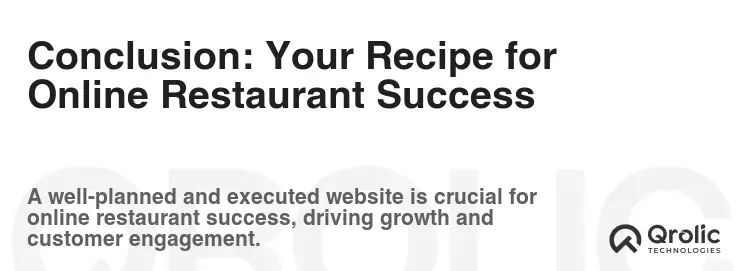
Creating a local restaurant website is a journey, not a destination. By following these step-by-step guidelines, you can create a website that attracts customers, showcases your restaurant’s unique personality, and drives business. Remember to plan carefully, invest in quality design and content, and continuously monitor and update your website to stay ahead of the competition. Your website is the key ingredient to your restaurant’s long-term success in the digital age. Good luck!
